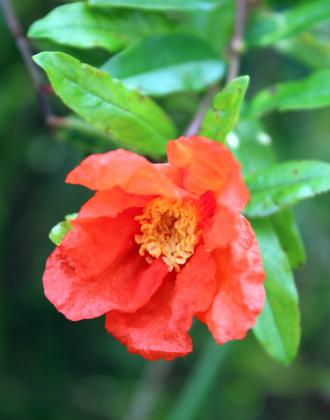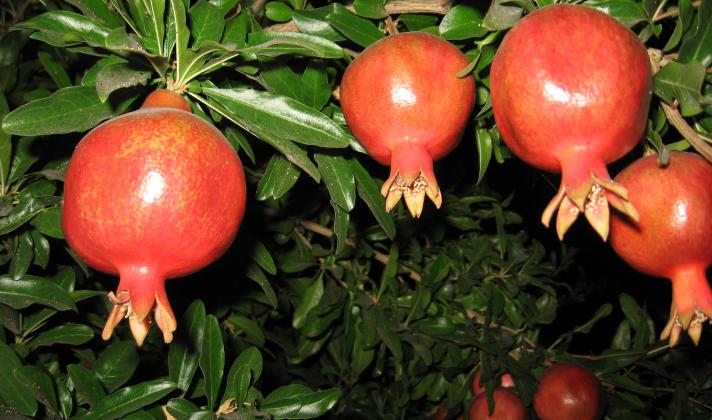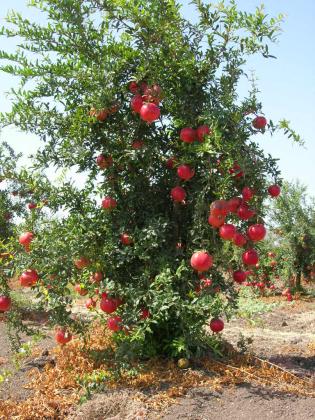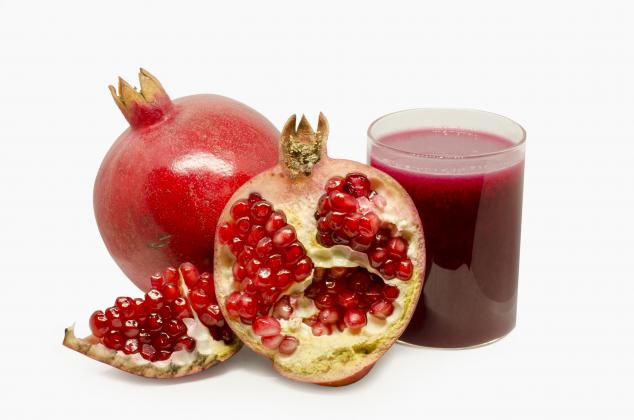Punica granatum - Inhibits corrosion of steel and other various metals
Punica granatum, pomegranate, means “apple with many seeds” and is common in Grimes County. It’s a deciduous tree or shrub, often with multiple trunks, usually about 10 to 20 feet high. Some branches may have thorns. Leaves, dark green and glossy, can be up to 3 inches long and almost an inch wide. Flowers, usually less than 2 inches wide, have 3 to 7 petals, are bright red, ruffley and odorless. They produce the fruit, a berry, 2 to 5 inches in diameter, which is usually deep red but is pale pink in some varieties. It has a hard-outer red husk, the pericarp and an inner, spongy mesocarp with a membrane where the seeds surrounded by juice sit inside arils.
Native to Iran and India, pomegranates have been part of human culture for millennia. Missionaries introduced them to the Americas in the 16th century. Because pomegranates have about 200 to 1400 seeds, it is a symbol of prosperity, fertility and metaphors linking the one to the many, the part to the whole.
Artifacts suggest that at one time pomegranates were considered a luxury item. A shipwreck discovered off the Mediterranean coast of Turkey in 1984 had pomegranates onboard along with perfume, ivory and gold jewelry. The items were dated to circa 14th century BCE.
When eating a pomegranate some spit out the seeds and some eat them getting the benefits of their fiber and micronutrients. Pomegranates are rich in vitamins C, K and folate. They are juiced, made into jellies and syrups such as the original grenadine syrup alcoholic beverages are made of. Dried seeds are used in granola. Ground seeds called anardana are used as a spice in Indian and Pakistani cooking. P. granatum is in the Food and Drug Administration Poisonous Plant Database at fda.gov.
Traditional medicine systems have used pomegranates to expel tapeworms. Bark tea was given to lessen the pains of childbirth and for “women’s issues.” The plant contains tannins and is astringent. Various parts have been used to treat diarrhea, infections, fever, sore throat, warts, etc.
Following are some articles from the National Institutes of Health, NIH, ncbi. nlm.nih.gov:
• “Potent health effects of pomegranate.”
• “Pomegranate for Your Cardiovascular Health.”
• “Pomegranate supplementation improves cognitive and functional recovery following ischemic stroke: A randomized trial.”
• “Effects of pomegranate juice on blood pressure: A systematic review and meta-analysis of randomized controlled trials.”
Pomegranates are used to make a red dye. The peel tans leather. The juice and peel are being studied for their ability to inhibit corrosion of steel and other metals. They may already be used that way. Below are some articles:
• Journal of Materials Science & Surface Engineering, jmsse.in, “Pomegranate Peel Extract as Green Corrosion Inhibitor for α-Brass in 2M HCl Solution.”
• Oriental Journal of Chemistry, orientjchem.org, “Characterization and Study the Inhibition Activity of Pomegranate Peel Extract for a-Brass corrosion in H2SO4 Solution.”
• International Journal of Materials Chemistry and Physics, aiscience.org, “Study the Pomegranate’s Peel Powder as a Natural Inhibitor for Mild Steel Corrosion.”




